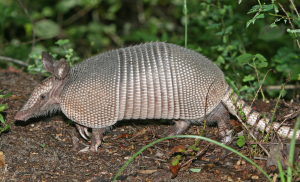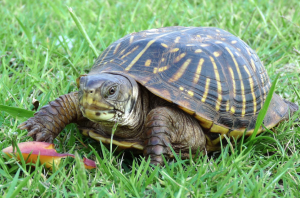Nine-banded Armadillo (Dasypus novemcinctus)
Nine-banded Armadillo (Dasypus novemcinctus)
Photo Credit: Tom Friedel/Creative Commons
Nine-banded armadillos are typically found in the southeastern United States, but their range has been expanding northward for the last hundred years. Climate warming will further extend their northern range. In Kansas they are typically found in shrubby or woodlands. Their most conspicuous trait is their protective armor. It consists of front and rear upper bony plates that are joined by nine moveable bony bands. Armor helps to protect armadillos from predators. However their tendency to jump up when threatened makes them frequent “road kill”. Nine-banded armadillos are nocturnal but their eyesight is poor because they lack cone cells in their retinas. Therefore they lack color vision. Their abandoned burrows are used by rabbits, opossums and burrowing owls. They feed on insects and their larvae, beetles, snails, white grubs and ants. Their young are identical quadruplets, each vulnerable to predation since they have not yet formed their hardened carapace.


